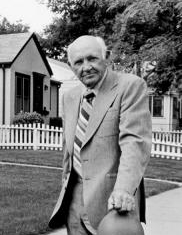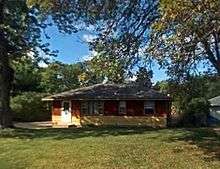Orrin Thompson (real estate developer)
Orrin Thompson (August 26, 1913 – March 7, 1995) was one of the largest real-estate developers in the United States. In the 1950s, a time when the post World War II population was exploding and in need of housing, he built and sold thousands of one-family homes, primarily in Minnesota. He contributed significantly to the creation of the mode of life in the twentieth century that became known as the suburb.[1]
Orrin Thompson | |
|---|---|
 Orrin Thompson, real estate developer |
Building plans, methods and growth
Thompson and his company, Orrin Thompson Homes, built rows and rows of modestly priced new homes that were termed subdivisions or tract housing. He then offered them to the generation known as the Baby Boomers.
To keep his prices down, he saved on building costs in a number of ways: by taking ideas from the assembly line, by creating great quantities of houses, by building them in proximity to each other, and by using the same plans over and over. In the 1950s these newly built homes were priced around $12,000.[2] Also, Thompson was able to build on inexpensive land away from the city, because the automobile and the public streets and highways had come of age, which gave homeowners greater mobility and the ability to commute.
Beginning with a few acres of prairie, Thompson created entirely new communities; first each basement would be excavated and constructed of cinder blocks, then each house would be erected on top of that, then the new family would move in. Lawns were then planted. The next step would be the addition of sewer systems, natural gas pipelines, then asphalt streets.[1] The communities grew, accompanied by the development of businesses and schools, and in some cases communities developed into cities where there had been no cities.[3] His large real-estate developments occurred in the Minnesota cities of Edina, Richfield, Bloomington, Cottage Grove, Apple Valley, and Coon Rapids.[4][5][6][7][8][9]
House design

His typical house design was known as the rambler, or the ranch-style house; a modest one family house. Its style borrowed modern ideas that had been developed by Frank Lloyd Wright and the Prairie School. The design emphasized horizontality, large windows, a relatively flattened roof, and eaves that extend like the brim of a hat. The prototype of this style is Wright's first independent commission, with its innovative design: the William H. Winslow House of River Forrest, Illinois built in 1893.[10][11]

Biography
Orrin Thompson grew up on the family farm near the town of Barrett, Minnesota. He believed that he would have become a farmer, had not the Great Depression forced him to take on other kinds of work.
First, he became an electrician, and then during World War II he found employment in factories in the midwest. He also worked in his brother's electric shop in south Minneapolis.[12] When the war ended, he observed that Minnesota was having a housing crisis: Soldiers were coming home, finding few places to live and were forced to move in with relatives, or into cramped apartments, or into the metal housing structure known as the Quonset hut.
Adding to the demand for housing was the G.I. Bill, which offered veterans assistance and encouragement to purchase homes. Thompson saw this situation as an opportunity, and began building his first houses in a rural area south of Minneapolis.[1] Considering that his name was attached to all of his houses, there were almost no photographs taken or displayed of him, except for one that shows him standing in front of some of his first houses.[13]
Criticism
The 1950s style of suburban real-estate development is mocked by Pete Seeger in the 1962 song “Little Boxes”, and it is criticized for contributing to urban sprawl, a phenomenon which results in diminished woods and prairie.[14][15][16]
References
- Kenney, Dave. Wackman, Hillary. Wagner, Nancy O'Brien. Northern Lights: The Stories of Minnesota's Past. Minnesota Historical Society Press. 2003. Page 300.
- Gerloff, Robert. Johnson, Kristi. Must, Peter J. Cape Cods and Ramblers; a Remodeling Planbook for PostWWII Houses. Archived 2016-12-13 at the Wayback Machine
- Beauregard, Robert A. When America Became Suburban. Minneapolis, MN: University of Minnesota Press, 2006.
- Atkins, Annette. Creating Minnesota; A History From the Inside Out. Minnesota Historical Society. 2007. Page 212.
- Gillund, Lesley Randels. Coon Rapids - a Fine City by a Dam Site; (History of Coon Rapids, Minnesota, 1849-1984). Coon Rapids Historical Commission. 1984.
- City of Apple Valley, Minnesota website
- The Transformation of a Dakota County Community Lebanon Township to Apple Valley, An Agrarian Township Becomes a Residential Success. Over the Years. A Publication of the Dakota County Historical Society. Volume 30, Number 1. December 1990. page 11.
- Vogel, Robert C. Suburban Development in Edina Since 1935; a Historic Context. Edina Heritage Preservation Board.
- Shaw, Bob. Era ends with closing of Cottage Grove's outdoor pool Pioneer Press. 27 August 2011.
- Samon, Katherine. Ranch House Style. Clarkson Potter Publisher. 2003. Page 12.
- Prois, Darlene. Humble and prolific rambler is becoming retro chic. Minneapolis - St. Paul Star Tribune. 18 February 2006
- History of Thompson Plumbing.
- Photo of Orrin Thompson standing in front his first houses in Minneapolis. Orrin Thompson houses, Copyright 2002 Star Tribune/Minneapolis St. Paul.
- Blackwell, Jon. 1951: American dream houses, all in a row. The Trentonian.
- Wood, Robert C. Suburbia: Its People and Their Politics. Boston: Houghton Mifflin Co., 1958.
- Jackson, Kenneth T. Crabgrass Frontier: The Suburbanization of the United States. Oxford University Press. 1985. Page 231.